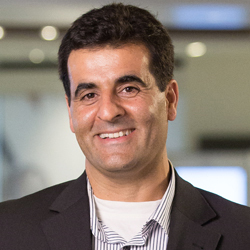A Brown University Ph.D. alum believes transforming the technology around earthquake catastrophic modeling is just a smartphone app away. He is developing the software for mobile devices that will rapidly identify earthquake activity, giving as much as a two minute warning, depending on how far away a person is from the epicenter. The available warning time can be computed with a simple rule: Every 10 miles away from the epicenter gives five more seconds warning. If you are fifty miles away, you get 25 seconds – not a lot of time for sure, but enough to shut down automated systems, or to grab children and move to the safest spot in the house.
 Battalgazi (Gazi) Yildirim, Sc.M ’08, Ph.D. ’12 began his startup company Zizmos in 2014, after postdoctoral work at Stanford. He studied under Professor George Karniadakis at Brown, specializing in numerical methods, and high-performance and scientific computing, penning his thesis, “Topics in Numerical Ocean Simulation.” His expertise involved ocean wave mechanics, where he found the fundamental physics similar both inside the earth and outside water. The methods he studied at Brown naturally led him to a similar interest in earthquake geophysics, and so when he left Providence, he headed straight for post-doctoral work in the Department of Geophysics at Stanford, developing algorithms and analytics for the Quake-Catcher Network. The QCN in Southern California is a collaborative initiative for developing the world’s largest, low-cost strong-motion seismic network by utilizing sensors in and attached to internet-connected computers.
Battalgazi (Gazi) Yildirim, Sc.M ’08, Ph.D. ’12 began his startup company Zizmos in 2014, after postdoctoral work at Stanford. He studied under Professor George Karniadakis at Brown, specializing in numerical methods, and high-performance and scientific computing, penning his thesis, “Topics in Numerical Ocean Simulation.” His expertise involved ocean wave mechanics, where he found the fundamental physics similar both inside the earth and outside water. The methods he studied at Brown naturally led him to a similar interest in earthquake geophysics, and so when he left Providence, he headed straight for post-doctoral work in the Department of Geophysics at Stanford, developing algorithms and analytics for the Quake-Catcher Network. The QCN in Southern California is a collaborative initiative for developing the world’s largest, low-cost strong-motion seismic network by utilizing sensors in and attached to internet-connected computers.
“My advisor at Stanford was one of the first who encouraged me to start a company,” Yildirim said. “He was actually one of the first investors.” Yildirim’s alpha tests were also funded with a National Science Foundation research grant and a $1 million grand prize from Verizon’s Powerful Answers competition. When the app triggers on a possible earthquake, it sends data to the cloud. The cloud software knows the location of nearby sensors. If enough are in the same neighborhood, it analyzes data from all of them. “If it is an earthquake wave, multiple sensors will trigger in sequence,” he said.
The free smartphone eQuake app has been downloaded about 200,000 times, rising among the top apps for several days during recent major earthquakes in the Philippines and Chile. Monthly users average about 25,000, and daily user average is about 3,000. Zizmos averages about 200 downloads on quiet days, and up to 2,000 when local shocks are felt. “More people installing the app will help us reach a critical mass, which will help provide the early earthquake warning for all,” he said.
Six months ago, the NSF extended funding for Yildirim, with the expectation that Zizmos will commercialize the idea for sustainability going forward. “There are two products for Zizmos,” Yildirim explained. “One is the earthquake early warning, the other is the dense earthquake data that would help structural engineers and insurance companies. We are now in the process of forming partnerships with individual states and insurance companies for that product-market fit.
“We believe that with four or five years of developing insurance premiums based on this data, constructed buildings will be more correctly and effectively rated. I can tell you stories about the challenges we face with targeting government and insurance as our two best potential customer segments. They are two of the most conservative and slow to act,” he said with a smile.
Born and raised in Turkey, Yildirim was witness to multiple casualties stemming from quakes growing up. “My dream is to help build technology that will one day be able to mitigate earthquake hazards and ultimately save lives,” he wrote in a blog affiliated with the Verizon competition. He earned his undergraduate degree in Aeronautical Engineering at Istanbul Technical University before coming to the U.S. to earn a master’s in Aerospace Engineering at Mississippi State. With one master’s degree under his belt, he then turned his attention to applied math and mechanical engineering at Brown to round out his education.
“Some of my happiest memories are from my days at Brown,” Yildirim said. “The campus is mixed with the city buildings, and there are wonderful seasons. Brown gave me opportunity to interact with other graduate students and to interact through multiple departments. I’m very proud of the work I did with Dr. Karniadakis, and I still rely on him for advice on life and careers,” he said.